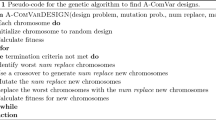Abstract
Mixed-level designs are widely used in factorial experiments. Clear effects criterion is one of the important rules for selecting optimal fractional factorial designs. It is highly desirable to know when mixed-level designs with resolution III or IV can have clear two-factor interaction components. This paper considers mixed-level designs with one or two high-level factors and some two-level factors, denoted as \((2^{r})\times 2^n\) and \((2^{r_1})\times (2^{r_2})\times 2^n\), respectively, and gives a complete classification of the existence of clear two-factor interaction components in such designs with resolution III or IV. The results reveal the structures of these designs.
Similar content being viewed by others
References
Addelman S (1962) Orthogonal main-effect plans for asymmetrical factorial experiments. Technometrics 4:21–46
Ai MY, Zhang RC (2004) \(s^{n-m}\) designs containing clear main effects or clear two-factor interactions. Stat Probab Lett 69:151–160
Chen BJ, Li PF, Liu MQ, Zhang RC (2006) Some results on blocked regular 2-level fractional factorial designs with clear effects. J Stat Plan Inference 136:4436–4449
Chen H, Hedayat AS (1998) \(2^{n-m}\) designs with resolution \({\rm III}\) and \({\rm IV}\) containing clear two-factor interactions. J Stat Plan Inference 75:147–158
Ke W, Tang B, Wu H (2005) Compromise plans with clear two-factor interactions. Stat Sin 15:709–715
Li PF, Chen BJ, Liu MQ, Zhang RC (2006) A note on minimum aberration and clear criteria. Stat Probab Lett 76:1007–1011
Mukerjee R, Wu CFJ (2006) A modern theory of factorial designs, Springer Series in Statistics. Springer, New York
Tang B, Ma F, Ingram D, Wang H (2002) Bounds on the maximum number of clear two-factor interactions for \(2^{m-p}\) designs of resolution III and IV. Can J Stat 30:127–136
Wu CFJ (1989) Construction of \(2^m4^n\) designs via a grouping scheme. Ann Stat 17:1880–1885
Wu CFJ, Chen Y (1992) A graph-aided method for planning two-level experiments when certain interactions are important. Technometrics 34:162–175
Wu CFJ, Hamada M (2000) Experiments: planning, analysis and parameter design optimization. Wiley, New York
Wu CFJ, Hamada M (2009) Experiments: planning, analysis and parameter design optimization, 2nd edn. Wiley, New York
Wu CFJ, Zhang RC (1993) Minimum aberration designs with two-level and four-level factors. Biometrika 80:203–209
Wu CFJ, Zhang RC, Wang R (1992) Construction of asymmetrical orthogonal arrays of the type \( OA(s^k, s^m(s^{r_1})^{n_1}\ldots (s^{r_t})^{n_t})\). Stat Sin 2:203–219
Wu H, Wu CFJ (2002) Clear two-factor interactions and minimum aberration. Ann Stat 30:1496–1511
Yang GJ, Liu MQ, Zhang RC (2005) Weak minimum aberration and maximum number of clear two-factor interactions in \(2^{m-p}_{IV}\) designs. Sci China Ser A 48:1479–1487
Yang JF, Li PF, Liu MQ, Zhang RC (2006) \(2^{(n_1+n_2)-(k_1+k_2)}\) fractional factorial split-plot designs containing clear effects. J Stat Plan Inference 136:4450–4458
Zhao SL, Chen XF (2012a) Mixed two- and four-level fractional factorial split-plot designs with clear effects. J Stat Plan Inference 142:1789–1793
Zhao SL, Chen XF (2012b) Mixed-level fractional factorial split-plot designs containing clear effects. Metrika 75:953–962
Zhao SL, Li PF, Liu MQ (2013) On blocked resolution IV designs containing clear two-factor interactions. J Complex 29:389–395
Zhao SL, Zhang RC (2008) \(2^{m}4^{n}\) designs with resolution III or IV containing clear two-factor interaction components. Stat Pap 49:441–454
Zhao SL, Zhang RC, Liu MQ (2008) Some results on \(4^m2^n\) designs with clear two-factor interaction components. Sci China Ser A 51:1297–1314
Zi XM, Liu MQ, Zhang RC (2007) Asymmetrical designs containing clear effects. Metrika 65:123–131
Acknowledgments
The authors would like to thank the two referees for the constructive suggestions and comments that lead to a significant improvement over the article. This work was partially supported by the National Natural Science Foundation of China (No. 11371223); the Program for Scientific Research Innovation Team in Colleges and Universities of Shandong Province of China; and the Program for Scientific Research Innovation Team in Applied Probability and Statistics of Qufu Normal University (No. 0230518).
Author information
Authors and Affiliations
Corresponding author
Rights and permissions
About this article
Cite this article
Zhao, Q., Zhao, S. Mixed-level designs with resolution III or IV containing clear two-factor interaction components. Metrika 78, 953–965 (2015). https://doi.org/10.1007/s00184-015-0535-y
Received:
Published:
Issue Date:
DOI: https://doi.org/10.1007/s00184-015-0535-y



